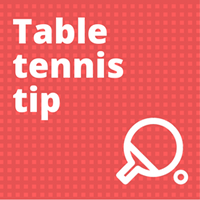I have been asked a few times by different players I coach to teach them a killer serve. A serve which opponents won’t be able to return. A serve which is guaranteed to win them point after point after point.
What do I tell them? No such serve exists. Any serve can be returned when you know how.
It’s true that at a lower level, you can win lots of cheap points with a couple of good serves. But when you play advanced players, the ball is much more likely to come back on to the table.
If you serve with the expectation that the ball won’t be returned, guess what happens? You ball-watch. You wait to see how your opponent deals with the serve, hoping they will make an error. When the ball is returned, you’re taken by surprise. You’re not prepared for the third ball. You’ll often play a weak shot and pass the advantage to your opponent.
So it’s very important to get into the habit of always expecting your serve to be returned. And not only should you expect your serve to be returned, you also need to think about how your serve is likely to be returned.
For example, if you serve crosscourt to your opponent’s backhand, 80%-90% of the time the ball will be returned crosscourt to your backhand corner. If you serve to the middle, the ball is more like to be returned to a more central position. If you serve really short, you may well get a short return. If you serve long, you’re almost guaranteed to get a long return.
And what about spin? If you serve backspin, more often than not it will be returned as backspin. If you serve topspin, more often than not it will be returned as topspin. If you serve sidespin (ball spinning clockwise, i.e. left to right) the ball will more likely kick back to your backhand. If you serve sidespin (counter-clockwise, i.e. right to left), the ball will more likely kick back to your forehand.
With this knowledge you can prepare much better for the third ball. Against a more defensive player, if you do a backspin serve crosscourt to their backhand, there is a good chance they will return the ball with backspin to your backhand. Therefore you can prepare to play a backhand topspin third ball attack. Against a more attacking player, there is a greater chance they will topspin your backspin serve, so you should also be prepared to play a block or counter-topspin.
I am slightly simplifying things here. You can never 100% guarantee the ball will be returned in the way you expect. Your opponent may have other ideas and return in a way you weren’t anticipating. But most players are fairly predictable (myself included!) and will only return each of your serves in one or two ways. Therefore you can make reasonable assumptions, based upon the strengths and weaknesses of your opponent, about how the ball is likely to be returned .
So with every serve you do, think about your spin, speed and placement and anticipate where the ball may be returned to. You can then prepare for the third ball, rather than be taken by surprise when the ball is returned. And if your opponent does make a mistake from your serve – either by putting the ball into the net or hitting it long – well that’s a bonus. But the important thing is that you were prepared for ball to be returned.
Want more service tips?
If you want more service tips, I recommend you join Tom’s TT Academy. You will also get access to a wide range of coaching content, including:
- in-depth courses
- training drills
- session plans
- video analysis
- fitness videos
- robot training videos
- member discussions
- skill challenges
- and lot’s more!
You can access all this content for less than £1 per week. New content is added regularly. Join hundreds of table tennis players around the world today at tomsttacademy.com

